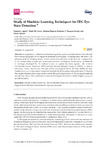Mostrar o rexistro simple do ítem
Study of Machine Learning Techniques for EEG Eye State Detection
| dc.contributor.author | Laport López, Francisco | |
| dc.contributor.author | Castro-Castro, Paula-María | |
| dc.contributor.author | Dapena, Adriana | |
| dc.contributor.author | Vázquez Araújo, Francisco Javier | |
| dc.contributor.author | Iglesia, Daniel I. | |
| dc.date.accessioned | 2020-11-04T15:03:18Z | |
| dc.date.available | 2020-11-04T15:03:18Z | |
| dc.date.issued | 2020-08-31 | |
| dc.identifier.citation | Laport, F.; Castro, P.M.; Dapena, A.; Vazquez-Araujo, F.J.; Iglesia, D. Study of Machine Learning Techniques for EEG Eye State Detection. Proceedings 2020, 54, 53. https://doi.org/10.3390/proceedings2020054053 | es_ES |
| dc.identifier.issn | 2504-3900 | |
| dc.identifier.uri | http://hdl.handle.net/2183/26640 | |
| dc.description.abstract | [Abstract] A comparison of different machine learning techniques for eye state identification through Electroencephalography (EEG) signals is presented in this paper. (1) Background: We extend our previous work by studying several techniques for the extraction of the features corresponding to the mental states of open and closed eyes and their subsequent classification; (2) Methods: A prototype developed by the authors is used to capture the brain signals. We consider the Discrete Fourier Transform (DFT) and the Discrete Wavelet Transform (DWT) for feature extraction; Linear Discriminant Analysis (LDA) and Support Vector Machine (SVM) for state classification; and Independent Component Analysis (ICA) for preprocessing the data; (3) Results: The results obtained from some subjects show the good performance of the proposed methods; and (4) Conclusion: The combination of several techniques allows us to obtain a high accuracy of eye identification. | es_ES |
| dc.description.sponsorship | Xunta de Galicia; ED431G2019/01 | es_ES |
| dc.description.sponsorship | Xunta de Galicia; ED481A-2018/156 | es_ES |
| dc.description.sponsorship | Agencia Estatal de Investigación de España; TEC2016-75067-C4-1-R | es_ES |
| dc.description.sponsorship | This work has been funded by the Xunta de Galicia (ED431G2019/01), the Agencia Estatal de Investigación of Spain (TEC2016-75067-C4-1-R) and ERDF funds of the EU (AEI/FEDER, UE), and the predoctoral Grant No. ED481A-2018/156 (Francisco Laport) | |
| dc.language.iso | eng | es_ES |
| dc.publisher | MDPI AG | es_ES |
| dc.relation | info:eu-repo/grantAgreement/AEI/Plan Estatal de Investigación Científica y Técnica y de Innovación 2013-2016/TEC2016-75067-C4-1-R/ES | |
| dc.relation.uri | https://doi.org/10.3390/proceedings2020054053 | es_ES |
| dc.rights | Atribución 4.0 | es_ES |
| dc.rights.uri | http://creativecommons.org/licenses/by/4.0/ | * |
| dc.subject | Discrete fourier transform | es_ES |
| dc.subject | Discrete wavelet transform | es_ES |
| dc.subject | Linear discriminant analysis | es_ES |
| dc.subject | Support vector machine | es_ES |
| dc.subject | Independent component analysis | es_ES |
| dc.title | Study of Machine Learning Techniques for EEG Eye State Detection | es_ES |
| dc.type | info:eu-repo/semantics/conferenceObject | es_ES |
| dc.rights.access | info:eu-repo/semantics/openAccess | es_ES |
| UDC.journalTitle | Proceedings | es_ES |
| UDC.volume | 54 | es_ES |
| UDC.issue | 1 | es_ES |
| UDC.startPage | 53 | es_ES |
| dc.identifier.doi | 10.3390/proceedings2020054053 | |
| UDC.conferenceTitle | 3rd XoveTIC Conference; A Coruña, Spain; 8–9 October 2020 | es_ES |






